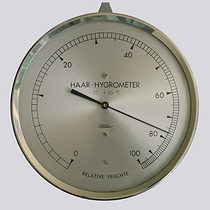Sensory Harp Care and Maintenance
Waking Spirit Sensory harps are among the most finely crafted acoustic instruments available today, using only premium solid tone woods which are carefully and patiently seasoned. We then build and finish our Sensory harps to exacting tolerances. The result of this fine craftsmanship is a tone, look and feel that is unmistakably 'Sensory' harp -- rich, bright and beautiful. Our harps are also built to be played, and with just a reasonable amount of care and periodic maintenance, they will deliver a lifetime of playing enjoyment. Understanding what affects your harp's well-being, both positively and negatively, will help you to apply the proper care and feeding. Below is a guide to help you maintain your Sensory harp and ALL other wooden instruments (Guitars, Other stringed instruments and, to some extent, Flutes etc.). Humidity is the amount of water vapor or moisture in the air. Temperature affects the amount of moisture the air can hold. Both of these factors affect wood because it is naturally "hygroscopic". This means that it takes on and gives off water. Therein lies the challenge. An instrument that absorbs too much moisture, through high humidity, expands and swells. This distorts the geometry of the instrument and, consequently, its tone and playability. Add high temperature, and humidity can weaken glue joints and even cause them to fail. With prolonged exposure, the glue under the sound board and/or back board will weaken, allowing them to pull off. Telltale signs of a "wet" instrument: • High action • Swollen top • String buzzing in the higher registers • Distorted back and sides • "Tubby," muffled tone, low volume • Finish cracks Overly dry conditions, or lack of sufficient humidity, can be equally detrimental to your instrument, causing the wood to shrink and crack. It can also cause poor tone and improper intonation. In dry regions (mountainous or desert areas) or northern climates, where heated air is common in winter, simple instrument humidifiers may not be sufficient. Room or household humidifiers may be necessary to maintain a proper environment. Telltale signs of a "dry" instrument: • Lowered action • String buzzing and lifting • Dips in the top or back • Finish and/or wood cracks Gradual changes in humidity and temperature will generally not harm a well-made instrument. At Waking Spirit Sensory Harps, we build and acclimate our harps in an environment of 49% relative humidity and a temperature of 75 degrees. So if you keep harp pretty close to these ranges, you should have no problems. The biggest danger caused by humidity and temperature is rapid or extreme changes. That’s because different parts of the instrument shrink and expand at different rates. For example, if your local humidity drops very rapidly, the instrument cannot acclimate itself uniformly, causing cracks or failure of glue joints in different portions of the instrument as it tries to "cope" with the drying situation. The same is true, in reverse, with high humidity. Extreme temperatures can wreak havoc, too. Heat weakens glue. Cold "chills" lacquer causing finishes to crack or craze. While you can’t control the weather, you can control your instrument's environment to a great extent. Here are some simple pointers. Keep your instrument in its case when you’re not playing it. It’s a lot easier to control humidity in a smaller volume of air. |
|
Purchase a home hygrometer/thermometer to keep tabs on the relative humidity and temperature. Adjust your home environment as necessary. Plants and humidifiers add moisture in dry winter months. Air conditioning controls humidity in the hot, muggy summer months. |
 |
Avoid storing your harp near sources of hot, dry air (such as forced hot air heating ducts), or cold, damp areas (garages, basements, closets with outside walls). Never, ever, transport your instrument in a car trunk. Temperatures inside car trunks are extreme in any kind of weather. It’s the quickest way to destroy an instrument. Even in the passenger compartment your instrument can be subjected to extreme temperatures. For example, please allow your instrument to warm up slowly before opening your case in a warm room after being transported in a cold vehicle. Abrupt changes in temperature can cause (i.e.: cold instrument to warm room) can cause finish crazing. When traveling cross country, keep in mind changes in local humidity – and protect your instrument accordingly. Guitar humidifiers that fit inside the sound-hole or extend into the body can be very effective but must be used with great care to avoid water damage. Check with a qualified guitar repair person before using them. Waking Spirit Sensory harps are finished with multiple coats of high-grade finish, hand-sanded between applications to bring out a deep shine. The resultant finish is thin, durable and acoustically compatible. The best way to preserve this finish is to keep it clean – wiping off perspiration and fingerprints with a soft, damp (not wet) cloth. Old, soft cotton Tee Shirts make excellent instrument cleaning cloths. While there are many commercial guitar/harp cleaners available, we feel that a rag slightly dampened with plain tap water and thoroughly wrung out will remove most dirt. Then buff with dry clean cloth. If you must use commercial products, avoid those with solvents, silicones or abrasives. Remember: polishing is not cleaning. Polishes remove finish along with dirt. FOAM/RUBBER/VINYL WARNING: We would like to advise our players that many types of instrument stands and straps that employ petroleum-based foam, rubber or vinyl can cause damage over time when in contact with nitrocellulose lacquer finishes. Because of this, many stand manufacturers have developed stands that are "lacquer safe", however due to variations in finish constitution between various makers it is always safest to treat stands as temporary storage for your instrument. The safest way to avoid finish damage when using a stand is to cover the foam/rubber parts with a soft cotton cloth (guitar polish cloths work well). The safest long term storage for your instrument is in its case. |
|
 |

